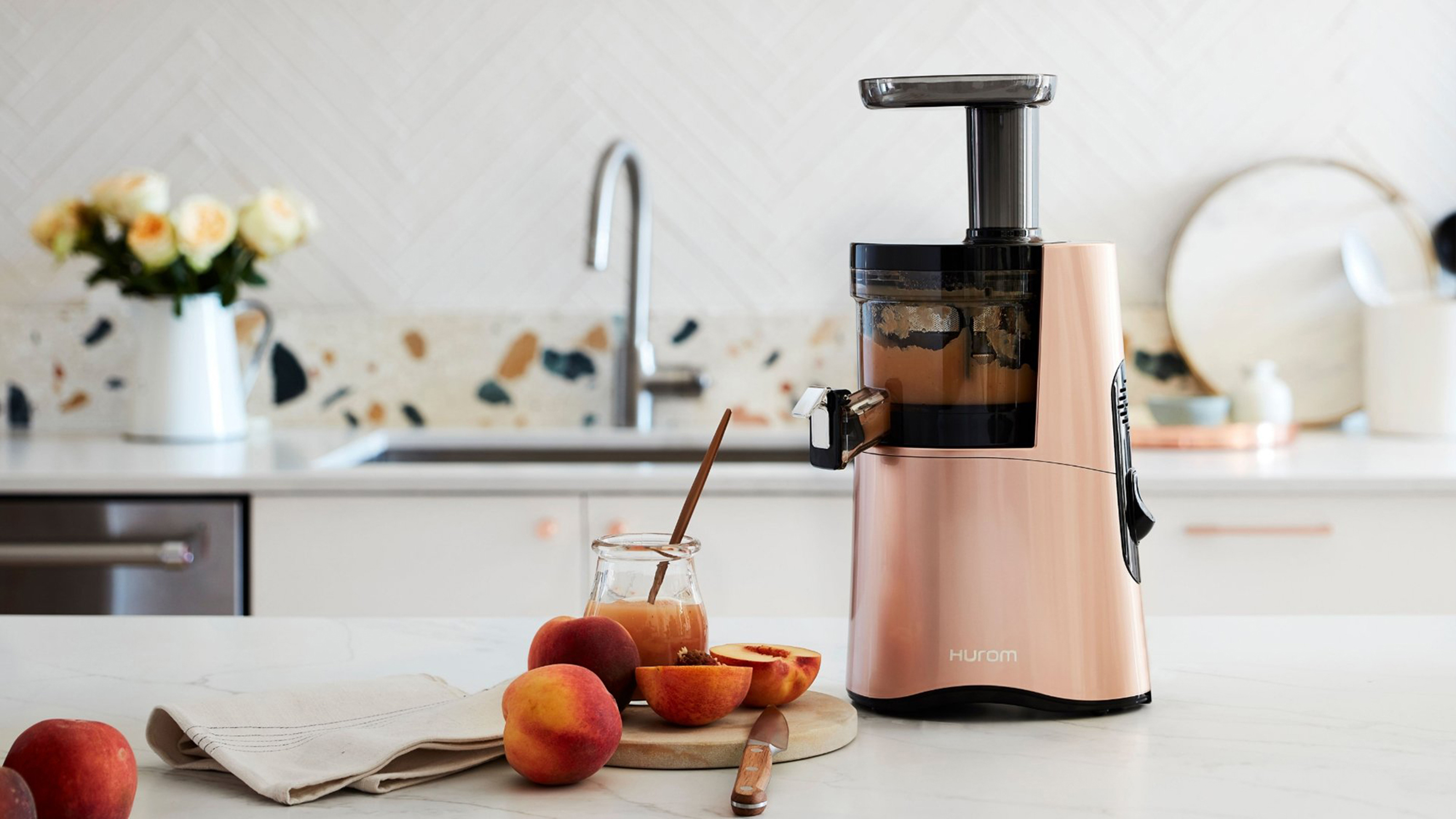
Why do I need the Hurom H-AA slow juicer? Let me explain, as I've reviewed five brilliant juicers, this one is up there with the best you can buy. I loved it so much solely because it leaves you with such a small amount of fruit and veg waste. Because no matter how good my intentions for the week are, there always seems to be slimy collateral damage in the crisper drawer of my fridge or my fruit bowl. Hence my obsession with a juicer.
We all know that what starts off as a bruise or blemish soon becomes a full-on funeral for those once-fresh pieces of fruit and vegetables, so I'm pleading with you: If you’ve got an abundance of fruits or vegetables, juicing with one of the best juicers is a great way to extract the flavor. Plus, fresh juice can be frozen into ice cubes and ice pops for summer treats. Or, if you're feeling poorly and can't leave your bed to grab a carton of orange juice from the store, this is one of the best orange juicers to get your dose of vitamin C.
The Hurom H-AA doesn’t come cheap though. To make sure it's worth the investment, I tried it out in my own home for a week. Keep scrolling to learn everything you need to know about using this juicer and why I loved it.
TLDR: What I thought of the Hurom H-AA slow juicer
Most serious juice fans will know a slow juicer, also known as a masticating juicer, is the best for extracting juice without destroying nutrients in the process, so it’s a good choice if you’re juicing for health.
Slow juicers like the Hurom H-AA work by chewing up the foods slowly to extract the juice, which is said to better preserve nutrients since no heat is introduced during the process. It also obtains the most possible juice from fruits and vegetables.
The main body of the juicer is compact, yet it has a weightiness that gives you the reassuring feeling that it’s well-built. The juice pitcher comes with a lid, which is very handy for storing juice in the fridge. Alternatively, the juice spout is positioned high enough so you can fit your own glass under it, perfect if you’re just juicing enough for one. The pulp container is also separate and it's easy to empty it without having to disassemble anything if you're making a large batch.
It’s supplied with three different strainers, the fine one is for making smooth juice, while the coarse one will allow you to juice trickier soft fruits such as berries. There’s also an ice cream strainer, which despite the name, is for pureeing frozen fruits like berries into sorbet-style frozen desserts.
Get small space home decor ideas, celeb inspiration, DIY tips and more, straight to your inbox!
Testing the Hurom H-AA slow juicer
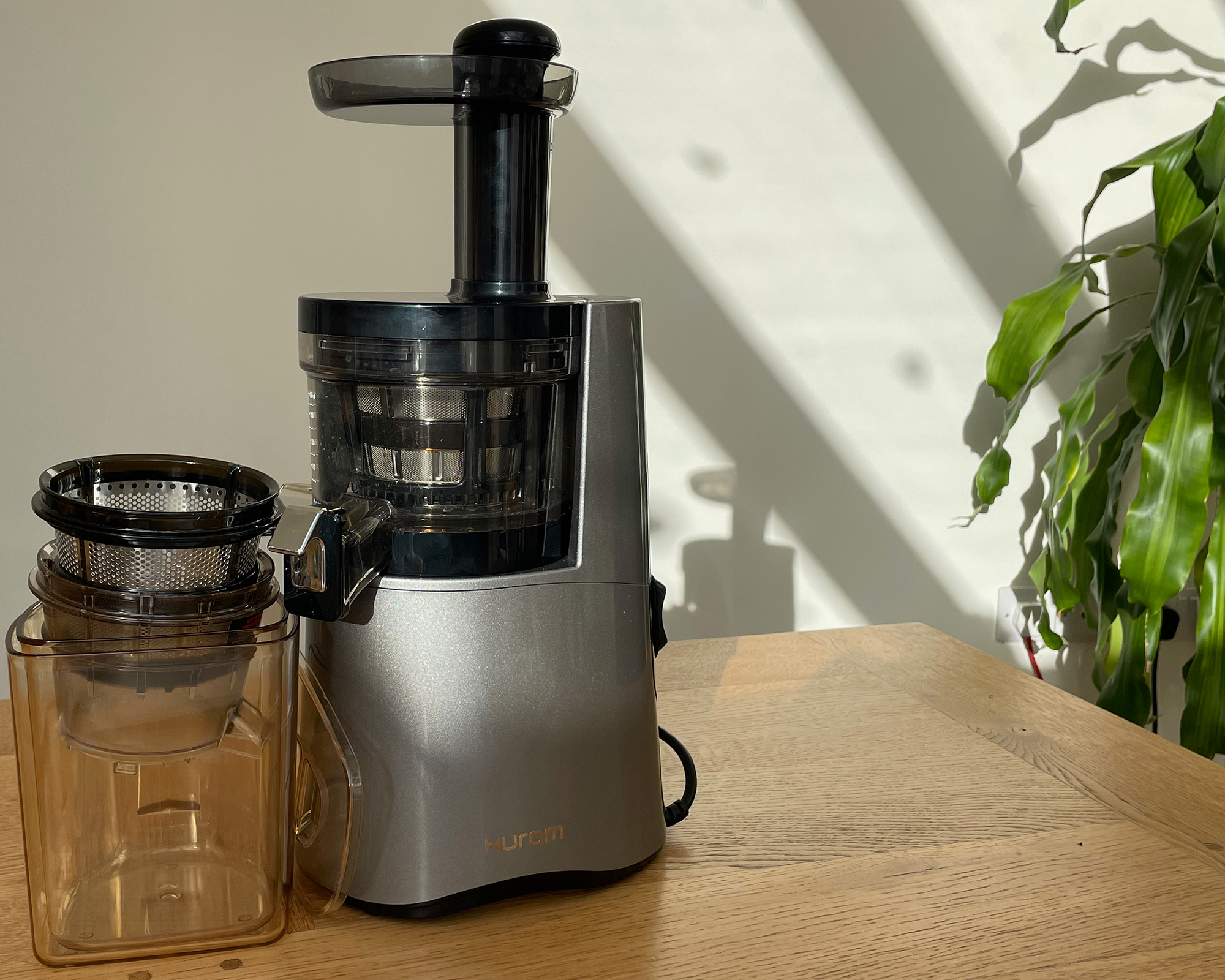
Assembled Hurom H-AA slow juicer on wooden dining table with large houseplant in background, sun is setting and creating shadows on white wall

Helen has been reviewing kitchen appliances for over 10 years and has reviewed many juicers during that time for a variety of different publications. She has reviewed five juicers in total for Real Homes, and she tested this model for one week to juice everything apples, oranges, vegetables, and raspberries — she even used it to make sorbet. Her favorite recipe is a mixed juice that contains some lower-sugar ingredients, such as leafy greens and ginger, for a punchy flavor.
The techy stuff
- Centrifugal or Masticating: Masticating
- Material: Plastic
- US Color options: Matte black, white, rose gold
- UK Color options: Red, black, silver, stainless steel
- Capacity: 1000 ml/35 oz juice pitcher with lid
- Feeding tube: Oval shape approximately 4 x 3.5cm/ 1.6 x 1.4inches
- Weight: 4.8 kg/10.6 lbs
- Power: 150 watts
- Dishwasher safe: No
- Other features: Recipe book included, three strainers, one speed
Unboxing the Hurom H-AA juicer
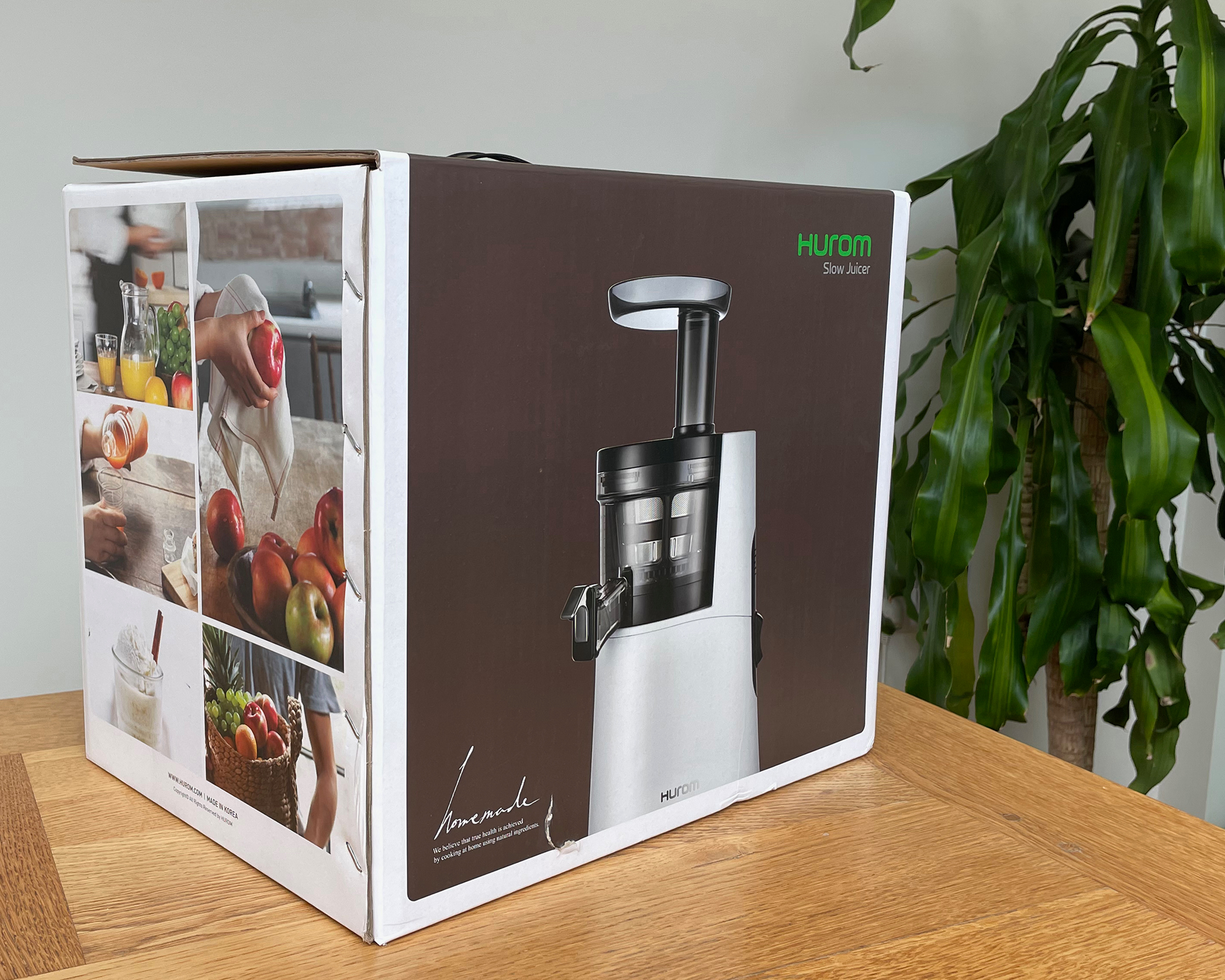
Hurom H-AA slow juicer in box on wooden dining table
The Hurom H-AA showed up in a matte finish box that had a more premium feel than the other juicers I’ve recently reviewed, plus the handle on top was a welcome addition for moving it through my house. Inside the box, there wasn’t too much plastic thankfully, just a few bags to protect and separate the various parts, otherwise, it was all cardboard.
Having reviewed several similar juicers, I was familiar with most of the parts. But if you’re new to juicing, it’ll probably feel a bit daunting when you remove all the different pieces from the box, and you’ll undoubtedly need the instruction manual to help you figure out how to assemble everything.
First impressions of the Hurom H-AA juicer
The initial assembly is fiddly, especially the first few times. It does become second nature once you’ve mastered it. As a gentle warning, you might have to do your own interpretation of the instruction manual. Frustratingly, both the manual and the recipe book have been poorly translated and there are some sentences that really don’t make a lot of sense. Given the high price tag, I would expect a properly written manual.
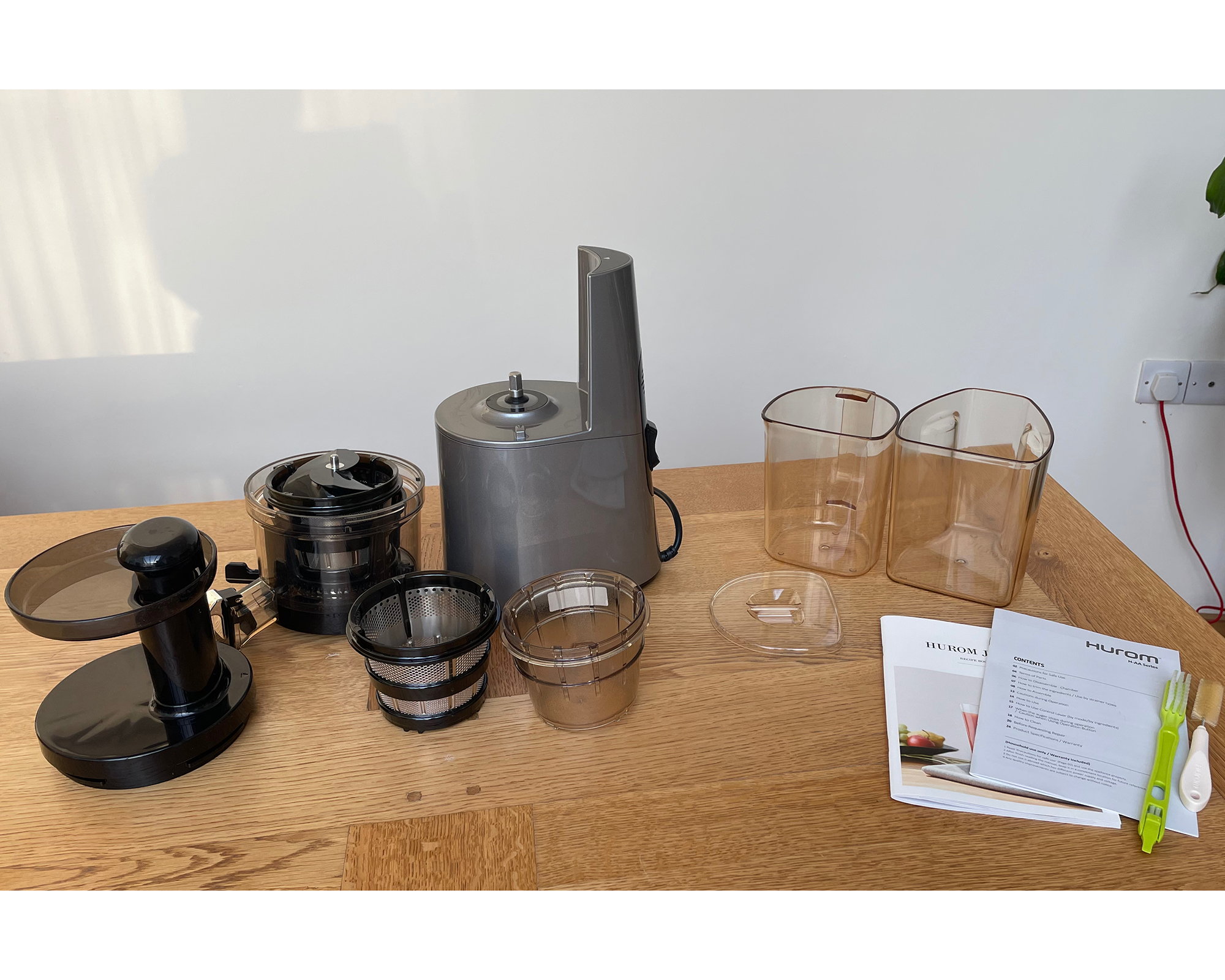
Assembled Hurom H-AA slow juicer on wooden dining table with large houseplant in background, sun is setting and creating shadows on white wall
That aside, the juicer itself does feel high quality and very sturdy. It looks great on the counter and there are various color options to choose from so you can coordinate it with your kitchen. Like many slow juicers though, it does have a small feed chute, so I could immediately tell a lot of chopping would be involved.
There’s just one juicing speed as well as a reverse setting, which is useful for when it gets stuck. The only other control is a lever with three positions: open, closed, and halfway between the two. Open is for cleaning. For most juicing situations, it should start in the closed position, then you should move it to the halfway position towards the end of juicing to help release the pulp. Again, the instructions around when the lever should be in each position are somewhat confusing.
There’s a juice cap to stop drips after juicing, but it’s also useful for mixed drinks. It can be left closed to allow different ingredients to mix well in the chamber before being released into a glass or pitcher. When not in use, I was glad to be able to slot most of the spare accessories inside the pulp container so it didn’t take up too much storage space and everything was easy to keep together.
Making apple juice
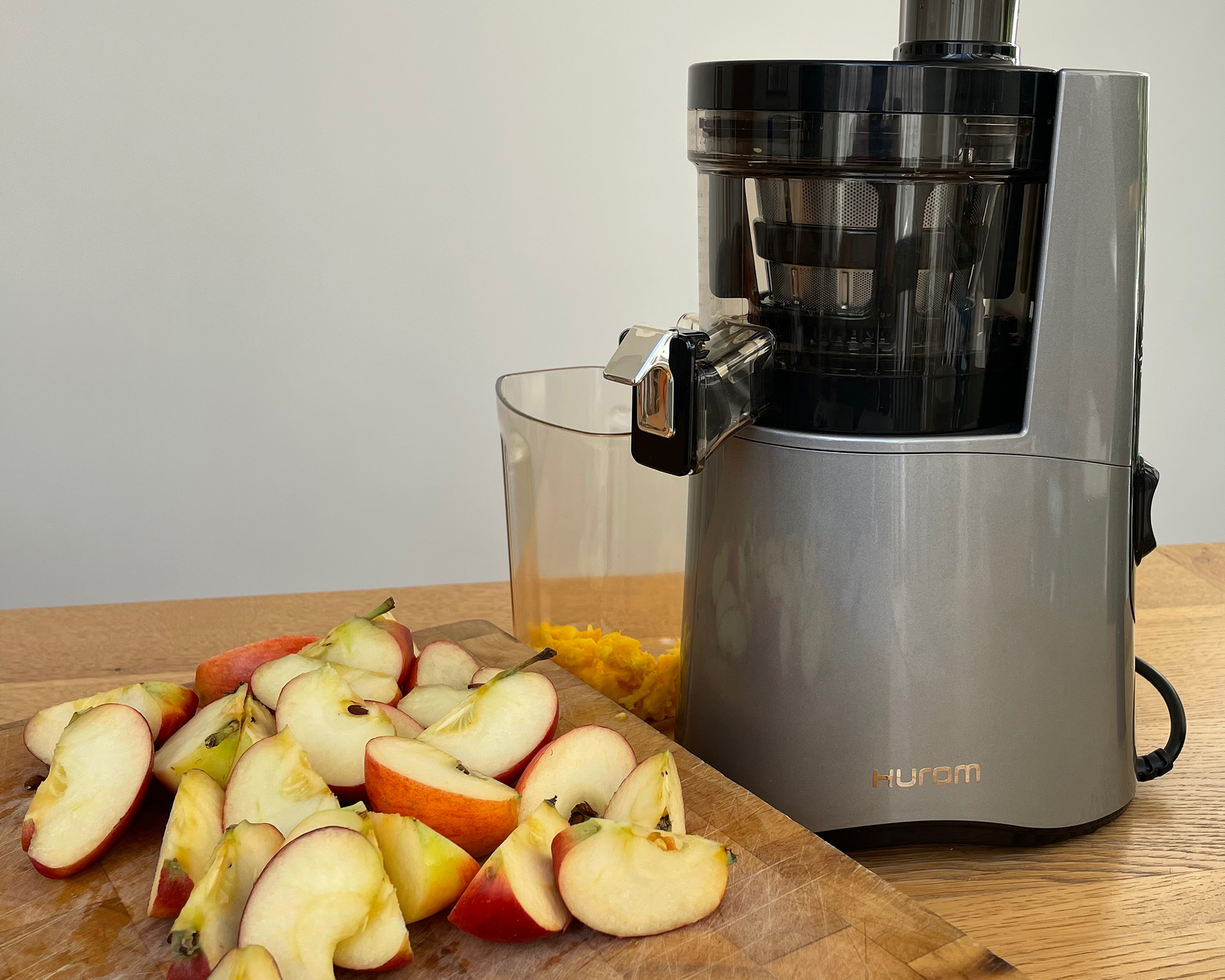
A generous portion of sliced apple wedges on wooden chopping board alongside Hurom H-AA slow juicer with apple juice prepared in appliance
A firm favorite in many households and the base for lots of mixed juice drinks, apple juice is one I had to try out. It was a great starting point for getting to know the juicer. My apples weren’t very big, but I still had to cut them into eighths, as quarters were too chunky to fit in the chute. The manual advises removing the seeds as they can be toxic, but quite frankly I couldn’t be bothered, so I left them in. I’m living life on the edge here!
It took around one minute and 45 seconds to juice four small apples, so it’s not exactly speedy. But the juice tasted fresh and sweet, and while it had a cloudy appearance, the texture was smooth with just a hint of graininess from some tiny specs of apple. There was some foam on top, which some people may find off-putting, but this is common when juicing at home, so it didn’t faze me.

Hurom H-AA slow juicer with yield of apple juice in plastic jug
From the fresh apples I put in, an impressively high 76% was extracted as juice, with just a dry fibrous pulp remaining. It was quite loud and squeaky as it ground its way through the apples and hit a maximum of 83 dB on my noise meter, which is similar to the noise level of a blender.
Making orange juice

Hurom H-AA slow juicer with bowl of fresh orange segments
I peeled four oranges and separated them into pieces that would fit inside the feed chute. It took around 1.5 minutes to make what was a deliciously smooth and clear glass of OJ.
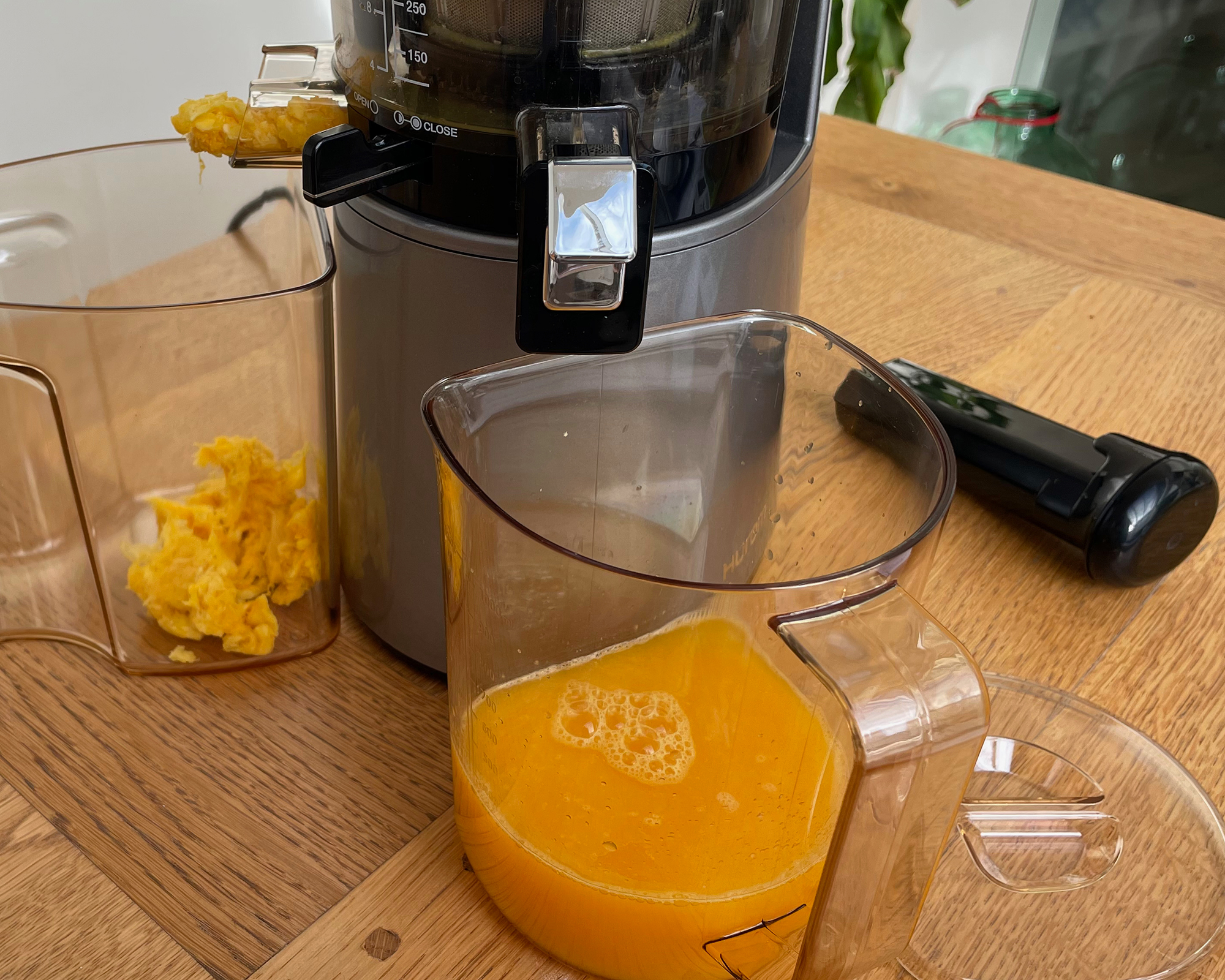
Mid-process of juicing oranges in Hurom H-AA slow juicer, pulp extraction shown with juice yield in jug
The pulp was dry and having weighed the oranges before juicing as well as the amount of juice produced, I was able to work out that it extracted a juice yield of 73%, which is very good and means it’s extracting virtually all the juice from the oranges.

Orange pulp in Hurom H-AA slow juicer on wooden dining table
Juicing oranges was much quieter than apples and only maxed out at 58 dB, which is far more pleasant and pretty quiet.
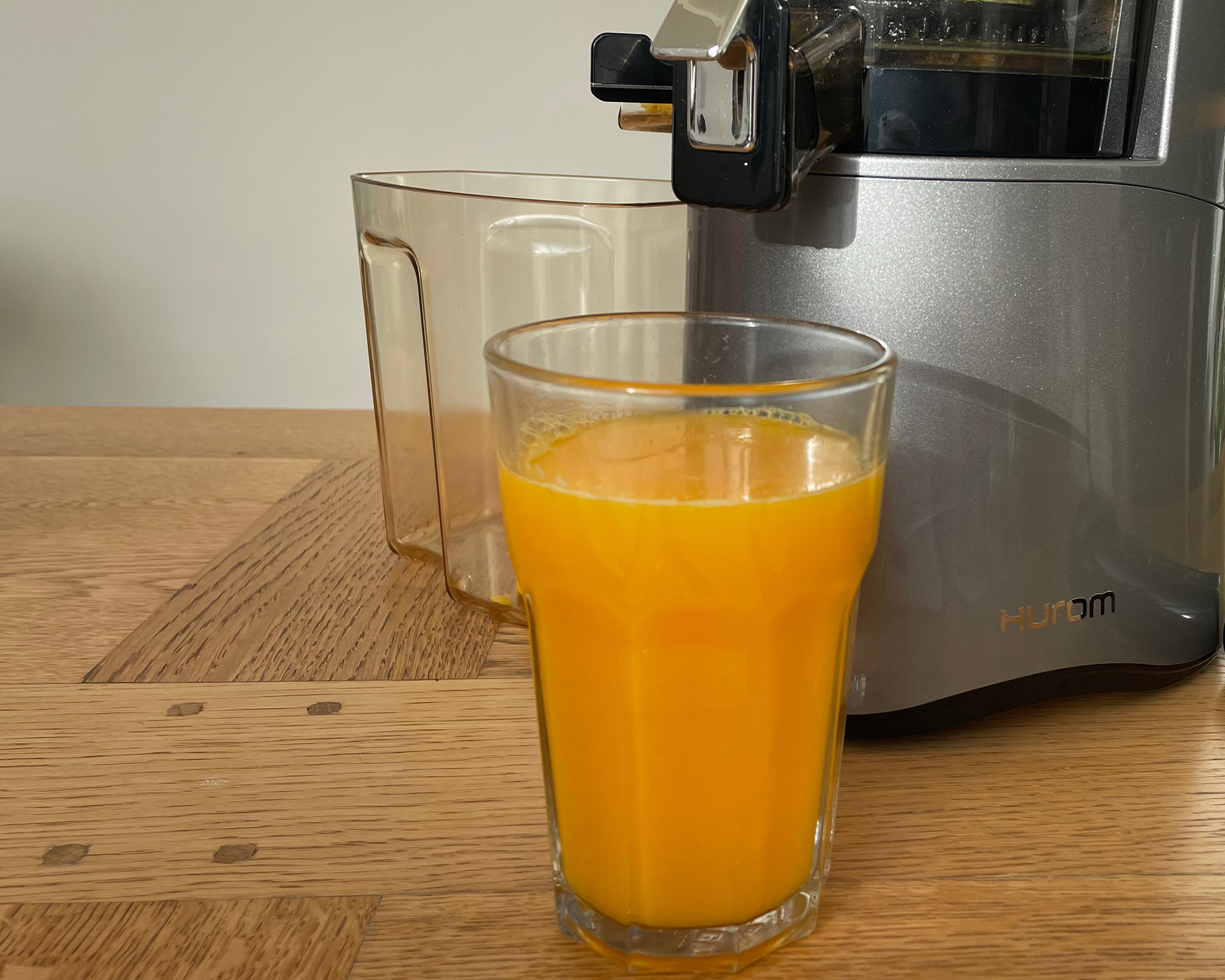
A full glass of freshly-squeezed orange juice prepared using Hurom H-AA slow juicer appliance on wooden dining table
Making a vegetable juice
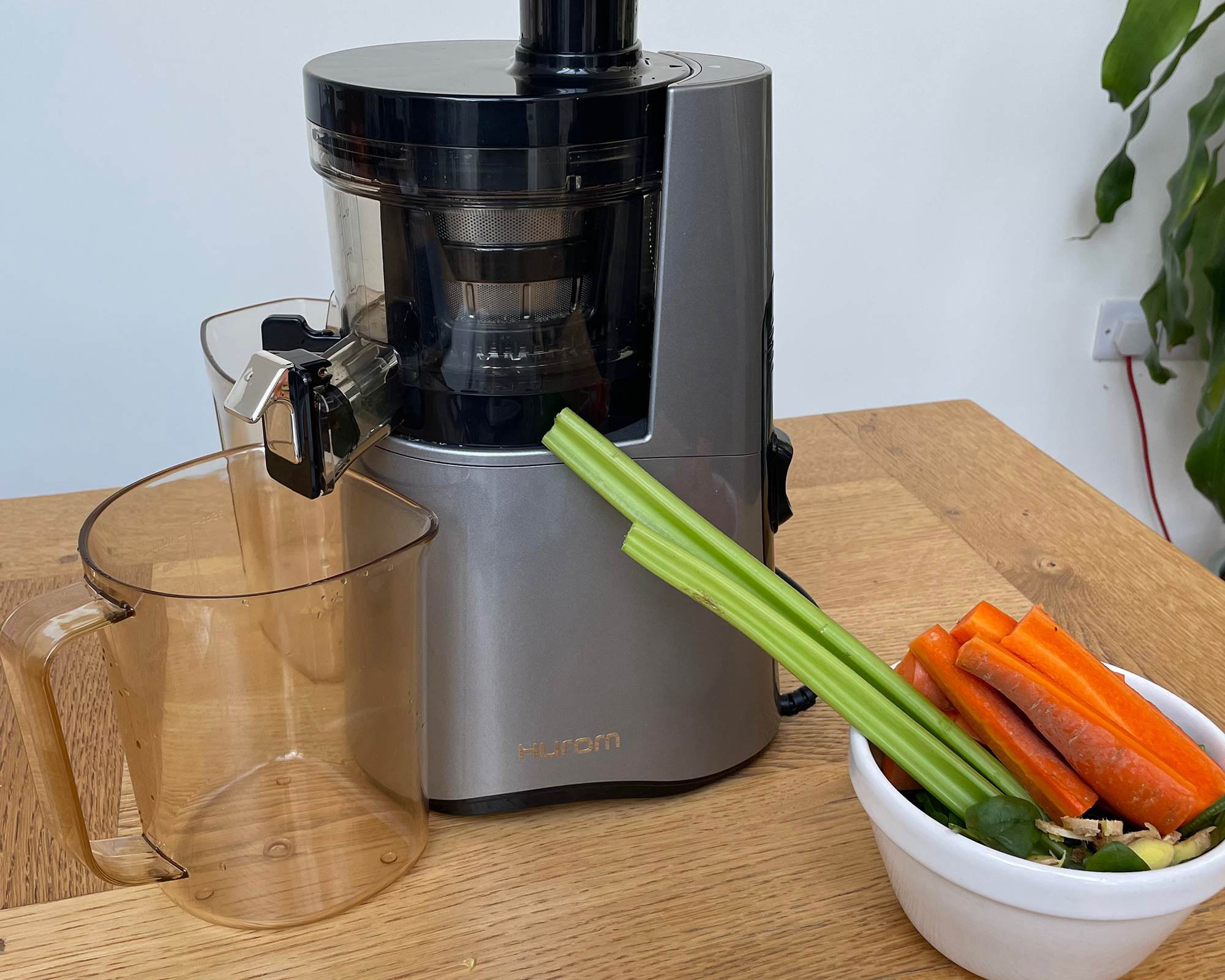
Hurom H-AA slow juicer with a selection of vegetables including celery, carrot, and spinach
I also tried making a lower-sugar vegetable juice containing celery, spinach, ginger, and carrot. I kept the celery stalks whole, but had to cut the carrot into batons, I didn’t peel it though. Frustratingly, the manual says ginger needs to be sliced thinly before juicing, which is a bit of extra work that I hadn’t anticipated. I didn’t peel it since the peel should be extracted as pulp.
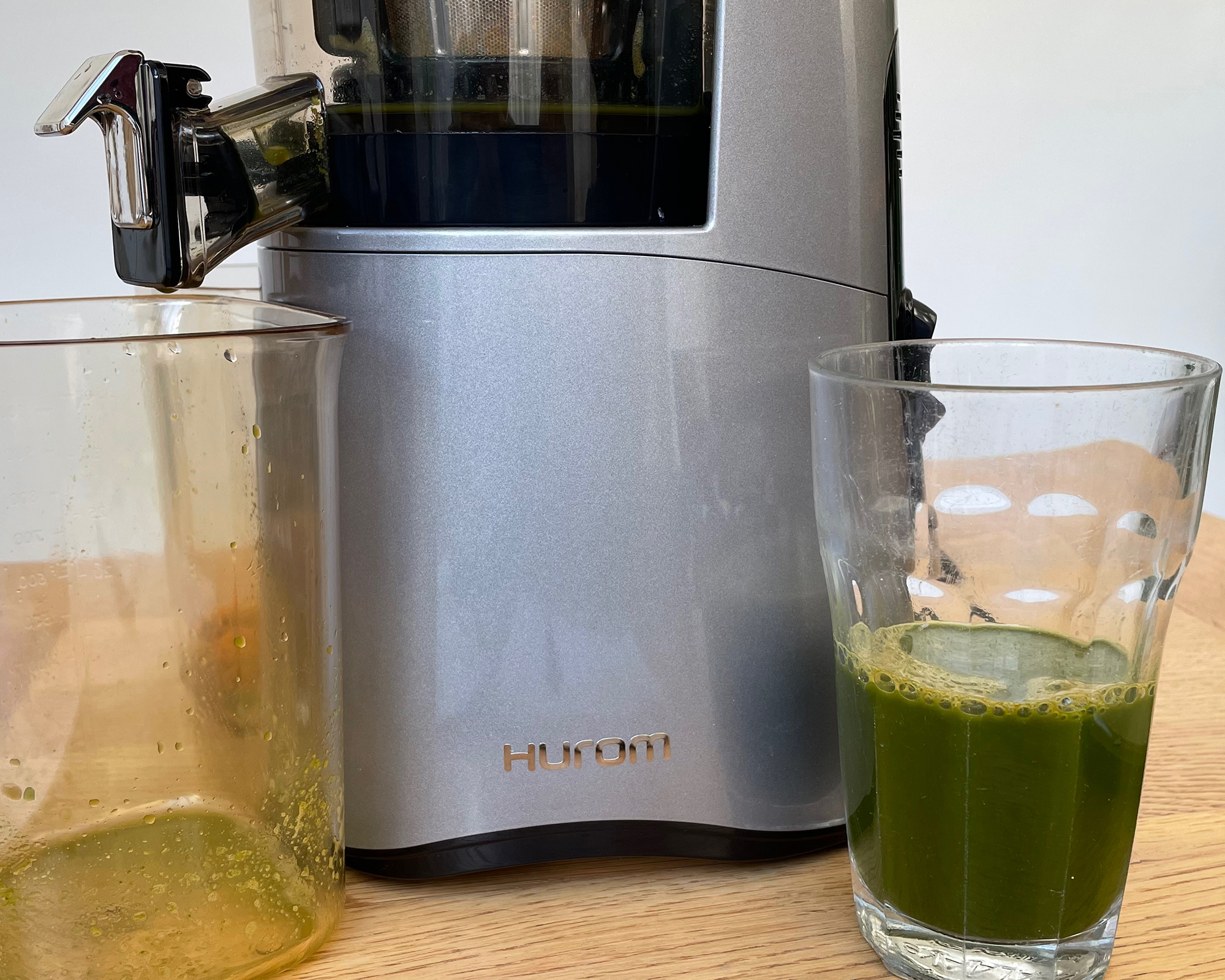
Green vegetable juice in glass made using the Hurom H-AA slow juicer appliance
I used the fine strainer again and it took around two minutes to produce a very healthy-looking green juice. It did get a bit stuck during juicing, and I had to flick it into the reverse mode to allow it to release whatever was stuck, luckily this did the trick.
This time the yield was just 51%, but that’s because the ingredients are all very fibrous. The pulp that ended up in the waste container was dry, and it was evident all the juice had been extracted from each of the ingredients.
The texture was slightly grainy because it contained some very fine pulp, but if anything, that made it feel healthier. The flavor was saved by the punchy heat from the ginger, otherwise, I’m not sure it would be the best combination.
Juicing raspberries
The coarse strainer is designed for juicing fruits like berries and bananas, so I grabbed a pack of raspberries and gave it a go. I slowly poured in 10.5 oz/300 g of fresh raspberries and let it work its magic.
It took around one minute and the juice yield was just 38%, which is quite wasteful. This was also evident in the pulp, which was much wetter than the pulp produced from other fruits. Having said that, it's a great way to remove all the raspberry seeds and create a thick puree for desserts.
Making a berry sorbet
I used 10.5 oz/300 g of frozen mixed berries, including blackberries, cherries, blackcurrants, and grapes for the sorbet. It took just under three minutes to get through all the fruit, partly because it got stuck a couple of times and I had to put it in reverse to release the jam.
Essentially, it chews up all the fruit and ejects it as a frozen puree, nothing ends up in the pulp container, so the only waste is what’s left inside the juicer parts. My mixture of berries didn’t come out completely smooth, and there were some chunkier pieces of skin and a few little chewy bits. But all things considered, it’s a great option for a speedy sugar-free sorbet.
How to clean the Hurom H-AA juicer
Cleaning juicers is never fun and unfortunately this one is particularly fiddly since none of the parts can go in the dishwasher. It’s supplied with two cleaning brushes, and I found one of them — the toothbrush-shaped one — particularly helpful for removing debris from the strainer. The small brush on the other end of it works well at getting trapped pulp from deep inside the pulp outlet.
It disassembles easily and for most of the parts, a thorough rinse in some piping hot water is enough to clean off any residue left from simple foods like apples. Drying it is super fiddly, so letting it air dry was my preference, but this isn’t always practical.
How does the Hurom H-AA compare to other juicers?
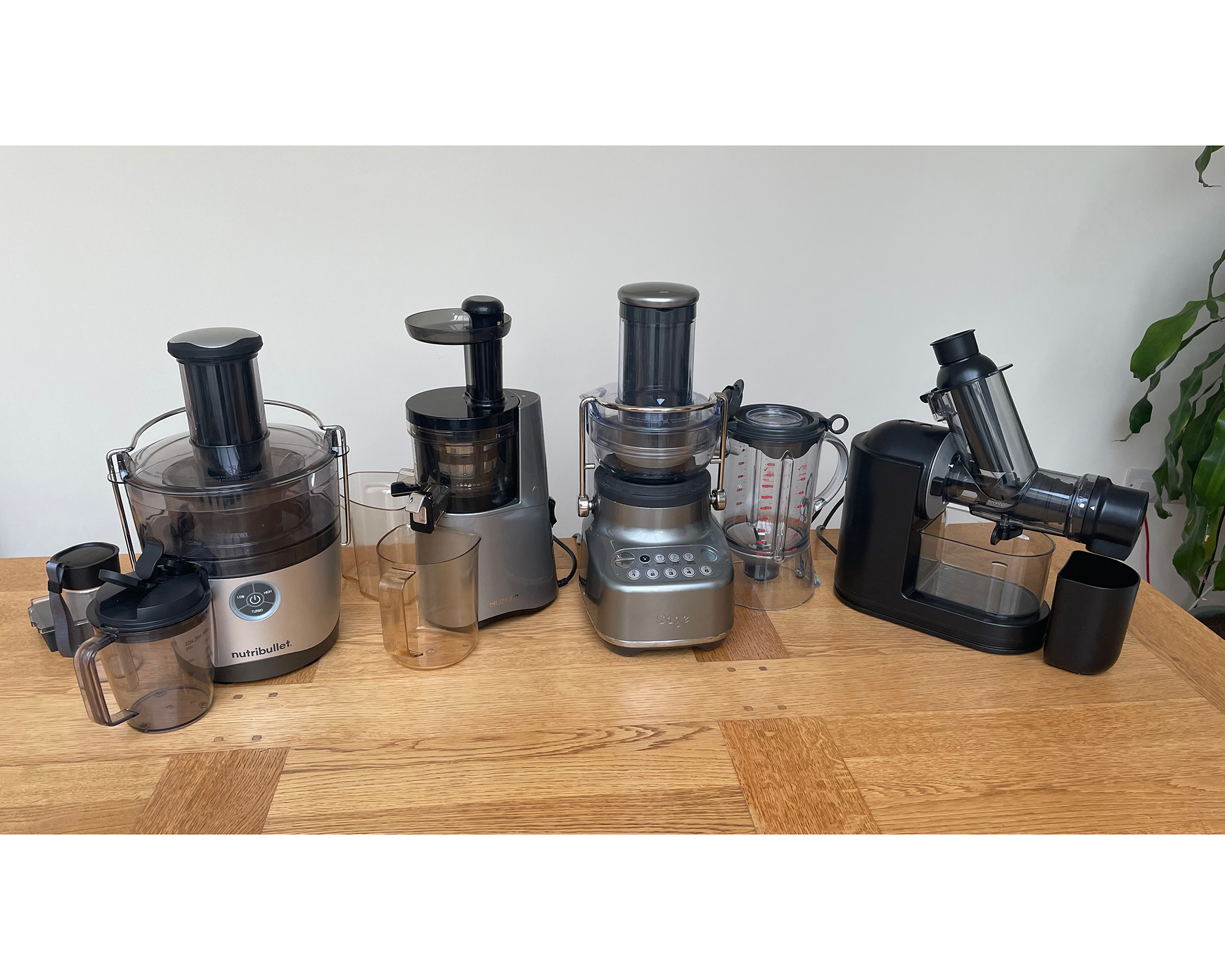
If you don’t mind switching to a centrifugal juicer, the Sage 3X Bluicer is another high-end juicer. Yes, it’s still expensive at around $650/£300, but you get more functionality for your money since it can be used as a full-size blender, too. Juice yields aren’t as good, but it offers the option to make smoothies with no waste or even a combination of juice and smoothie.
You could save a significant amount of money by choosing the Nutribullet Juicer Pro. It costs just $100/£130 and surprisingly, juice yields are similar to the Hurom HAA. Plus, all the parts can go in the dishwasher, so it’s easier to clean. That said, it’s a centrifugal juicer, which means the juice can be frothy. It’s also bigger, so it'll take up more space in your kitchen.
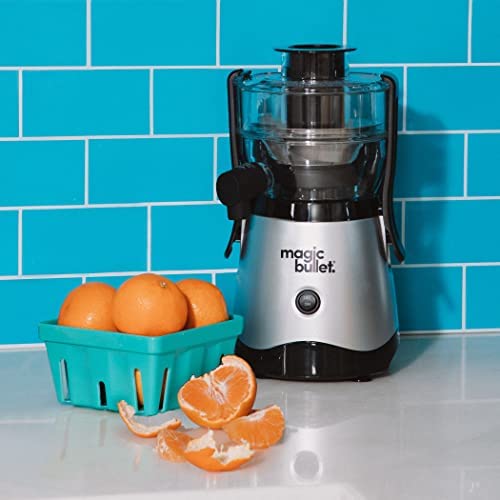
A compact, lightweight, and budget alternative
Type: Centrifugal
Dimensions (in): 7 x 6 x 11.5 in
Cord length (in): 39.73 in
Weight (lbs): 6.07 lbs
Power: 400 W
Jug capacity (fl oz): 16 oz
Read our Magic Bullet mini juicer review for more info.
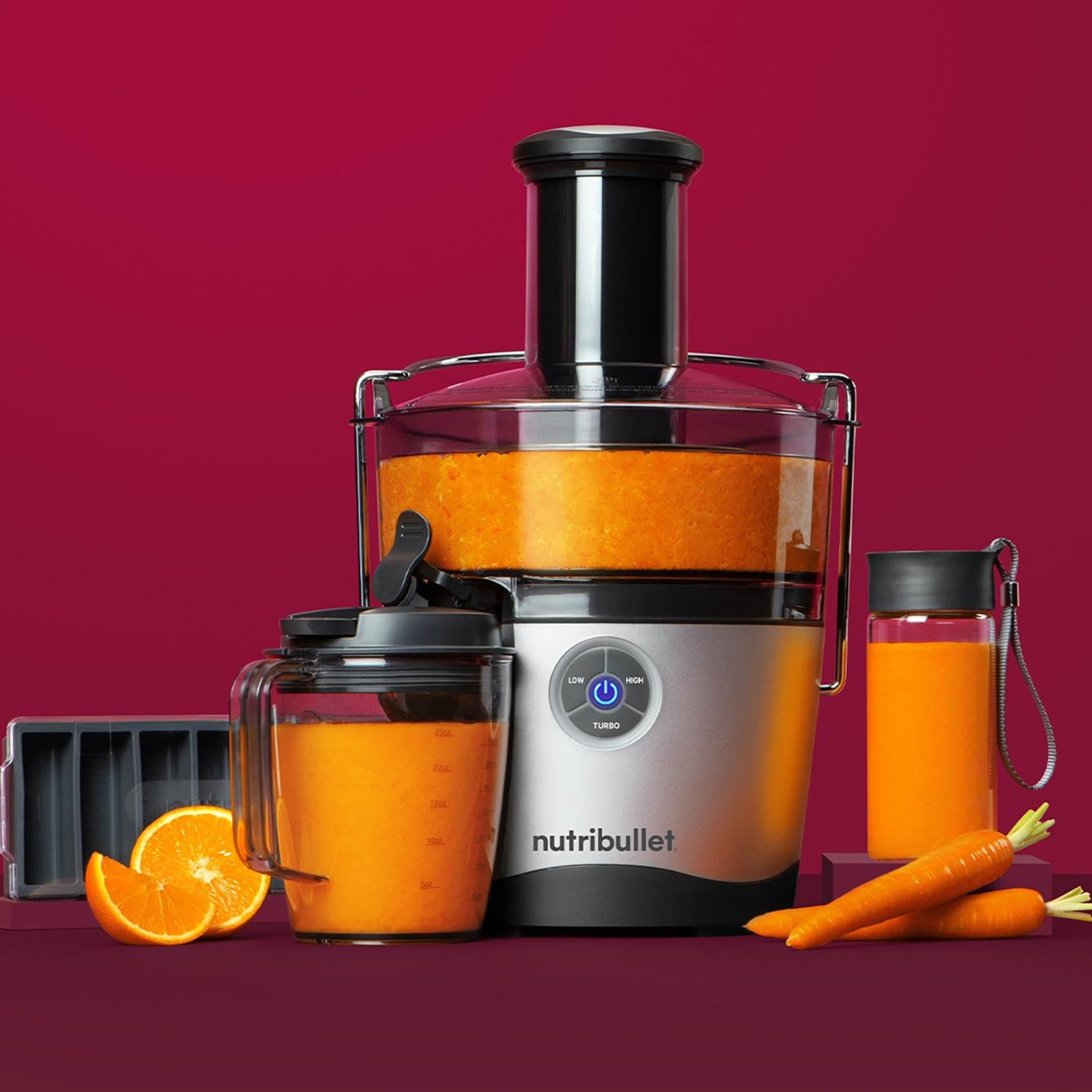
A 5-star rated alternative Hurom H-AA
Type: Centrifugal
Material: Plastic
Capacity: 800 ml/27 oz juice pitcher with lid and froth separator. 2,000 ml/75 oz pulp container
Feeding tube: 76 mm/3 in
Power: 1,000 watts
Weight: 7.5 lbs
Dishwasher safe: All parts except the food pusher
Other features: Three speed settings, dual size pusher
US model supplied with: Two 11-oz glass to-go bottles, 4-oz freezer tray, 2-oz freezer tray, and cleaning brush
UK model supplied with: 340 ml glass to-go bottle, 118 ml freezer tray, and cleaning brush
MSRP/RRP: $159.99/£299.99
Read our Nutribullet Juicer Pro review for more info
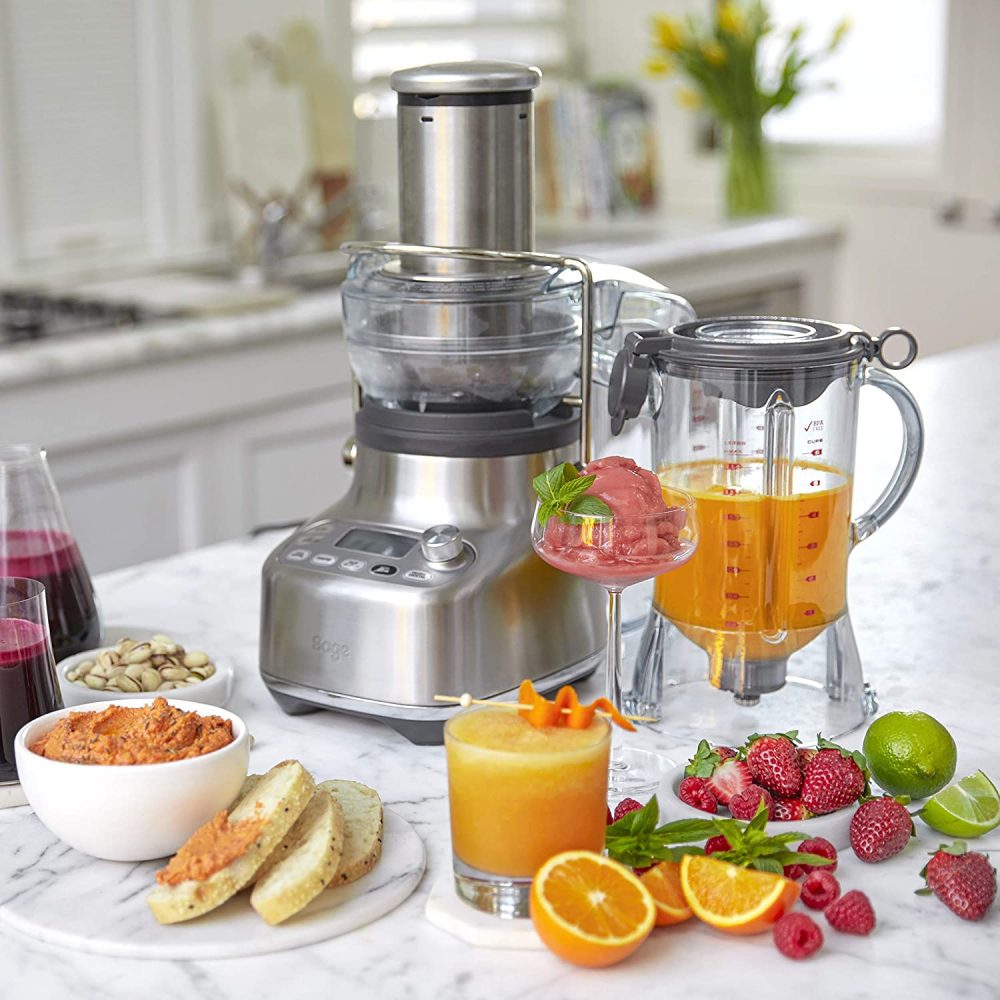
The best hybrid juicer-blender combo
Type: Centrifugal with cold spin technology
Material: Plastic
Capacity: 1500 ml/50 oz juice jug with lid and 3000 ml/100 oz pulp container
Feeding tube: 88 mm/3.5 in
Power: 1,000 watts
Dishwasher safe: All parts except the food pusher
Other features: Five speed settings and four one-touch programs
Should you buy the Hurom H-AA slow juicer?
You can definitely save money buy purchasing one of the more budget-friendly models. But, that doesn’t mean you should. With excellent juice yields, this juicer minimizes the amount of waste, so while it might be an up-front investment, if you do a lot of juicing you’ll potentially save money in the long run since you’ll get more juice from each piece of fruit. Plus, a cheaper model won’t necessarily be able to produce a tasty sorbet and slow juicers are said to produce a premium-quality juice.
With that being said, for occasional juicing, this one might be overkill and a cheaper model may be all you need. And if you want to avoid fiddly cleaning you might be better off looking for a juicer with dishwasher-safe parts.
About this review
After completing a home economics degree, Helen went on to work for the Good Housekeeping Institute and has been reviewing home appliances ever since. She lives in a small village in Buckinghamshire in the UK and was loaned the Hurom H-AA by juicers.co.uk so she could try it out in her own home.
Helen reviewed this juicer alongside three others for Real Homes, so she could make informed comparisons on the speed of juicing, juice yields, and ease of use. She might have felt like she’d been on a juice cleanse by the end had she not been heavily supplementing all this juice with copious amounts of cheese and mashed potatoes.

Helen McCue is a freelance contributor who trained as a Home Economist. After starting her career in the food industry, she moved into home appliance reviews, utilising her cooking skills and experience to put all kinds of products to the test, and over the years has reviewed hundreds of home and kitchen appliances for a variety of publications.
